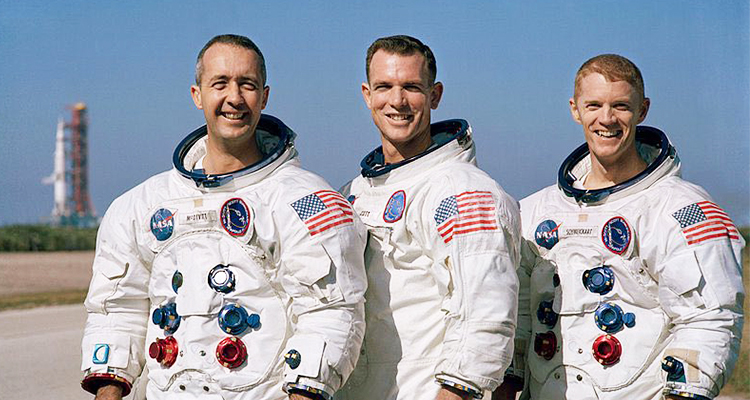As the rocket blurred into the clouds, I watched the joyful exuberance of the hundreds of kids around me all still spellbound by the launch of Apollo 9. As I kept turning, this view was quickly replaced as the center of my attention by the expressions on the faces of my teachers, the principal and the school nurse. Their expressions took me aback … they were, all of them, crying. Their faces were tear-soaked, their reddened eyes still fixed to the single television set on the school stage. — Robert E. Strong
In the Apollo Pantheon of human space missions, Apollo 9 (launched March 3, 1969) may not make your top three missions, but without the lessons learned, techniques tested and equipment examined on the Apollo 9 mission, there would be no Apollo 11.
Apollo 9 was the first Apollo mission to test all of the needed equipment and procedures to fulfill a human moon landing. Without Apollo 9, there would be no human moon landing.
We often forget the accomplishments of Apollo 9. Each Apollo mission had its own form of spectacle, its own human drama and theater. Apollo 9 is often overlooked, not because it was a lackluster human space mission. Apollo 9 is forgotten only in that, at the time, it was not as appealing to the general public — due to the technical and multifaceted testing nature of its mission. Apollo 9 was, in essence, an engineering verification of all the necessary procedures and equipment needed to send humans to the Earth’s moon and bring them safely back to the Earth. Apollo 9 was the technical and engineering space mission that was necessary to ensure that the moon-walking astronauts of Apollo 11 would make it safely back home.
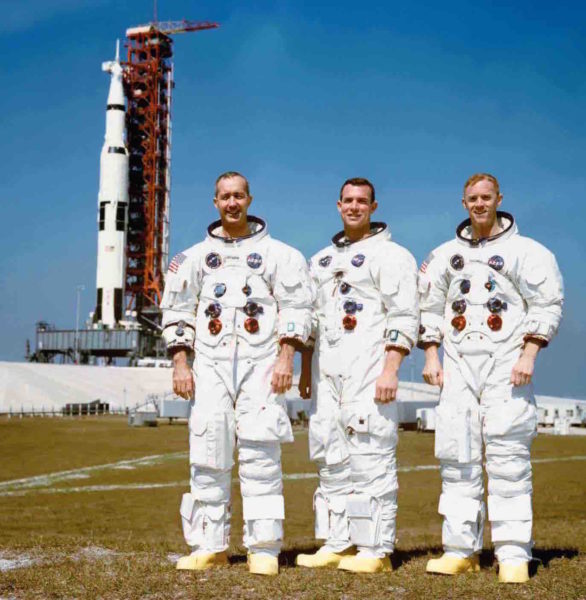
Today, we are more likely to remember the missions of Apollo 8, 11, 13 and 17.
Apollo missions 8, 11 and 17 had more of a scripted Shakespearian nature where representatives of humanity were taking us, all of us, on a journey of spatial exploration and human self-reflection. We were with our radios, newspapers and televisions — first-hand witnesses to the greatest accomplishments many of us could ever imagine and, sadly due to national and world politics, would ever again see.
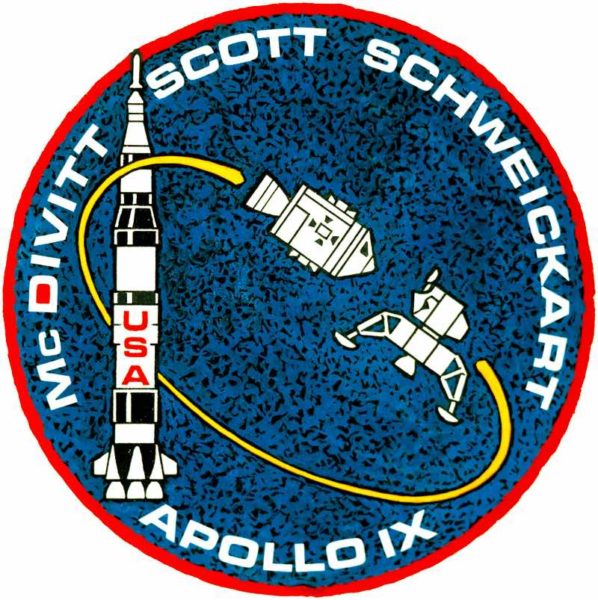
Apollo 13 held the world’s attention as well as any of the Greek tragedies, but, being played out high over our heads in the hostile sea of space — beyond all possible helping hands. There was a failing lifeboat in space with three of our species fighting for their lives with time running out, all played out under the watching eye of the world media.
The entire world was looking on unable to help, powerless to do anything but pray and will them to safety with three billion concerned fellow world citizens, a billion concerned persons for every person slowly dying in Apollo 13.
These four Apollo missions, due to their human nature, often overshadow the other more “technical” Apollo missions.
This does not mean that Apollo 9 was a lesser accomplishment. Apollo 9 was just different in nature.
Half a century ago, I was a 10-year-old sixth-grader. At the time of Apollo 9, I did not fully appreciate the extensive range and scope that was the Apollo 9 mission. I did, however, appreciate how important the Apollo missions were. It was not lost on me as a sixth-grader that NASA was trying to get humans, American humans, to the moon.
This enterprise was the culmination of all the launches I watched earlier of the Mercury missions and the Gemini missions.
Indeed this Apollo 9 launch was such a big deal that all the students, teachers, lunchroom personnel, custodians and office personnel of Chamberlayne Elementary School in Henrico County just outside of Richmond, (East) Virginia, were brought into the cafeteria to watch the televised liftoff.
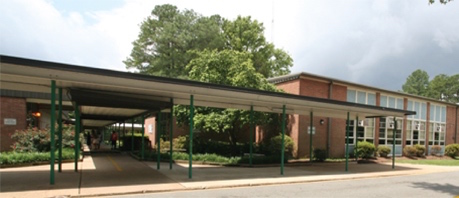
It occurred to me that day that this same thing was likely going on in every other school in the nation. The people in charge of my school thought that everyone should watch the event — so it became even more important. I realized that I was a part of something big — real big. An event big enough that it was likely being shared with millions of other kids across the country in cafeterias just like ours, and perhaps, this was being played out in other countries around the world. Liftoff was scheduled for 11 a.m. Monday morning, March 3, 1969, for the east coast of the United States.
As the seconds were ticking by, the television announcer said, “We are 90 seconds and counting.” He said some more words, I glanced at the large cafeteria clock with its thin, red second hand, and thought that is real close to a minute and a half before 11 a.m.
I started watching the school clock, and the announcer said, “One minute 20 seconds and counting. …” I knew our school clock was set as close as the principal could get it to the actual time. The launch of Apollo 9 was scheduled for exactly 11 a.m. my time, that was 10 a.m. Central Time, 9 a.m. Mountain Time and 8 a.m. on the west coast! Somebody at NASA had carefully planned this event to launch on the hour exactly so every school kid in the continental United States could watch this event live at their school! The event felt even bigger.
The television announcer was going down a checklist as the number of seconds grew less. The voice on the television said, “We are go — 30 seconds and counting.” … “Guidance release” — something broke away from the rocket, it must be the Guidance Release.
“15.” The kids in the room began to squirm — they knew it would not be much longer now. The image of the close-up of the rocket is replaced by a more distant rocket across a calm lake.
“14.” How many people were watching this right now with my friends and me?
“13.” I was trying to estimate the number when the familiar countdown chant began “10,” “nine, we have ignition sequence start,” (“eight,” then to swell “seven”), “six,” everyone was joining in now in a loud roar.
“Five” — a burst of fire bubbles out from under the rocket.
“FOUR” — the fire bubble gets bigger.
“THREE” — the fire bubble expands to hide the bottom half of the rocket.
“TWO,” “ONE,” “ZERO! — all engines running — commit” a cloud quickly forming is now far higher than the stationary rocket.
“LIFT-OFF — we have Lift Off at 11 a.m. Eastern Standard Time.”
Wow, right on the nose, 11 a.m. exactly. On cue, the stationary rocket slowly rises above the smoke and clouds. The sounds of the announcer and the rocket were being drowned out by the cheers and shouts of the whole room in unison. I turned from the shaky image of the Saturn 5 rocket standing on a bright piece of the sun and perched atop a tower of smoke and clouds and looked around at the cafeteria.
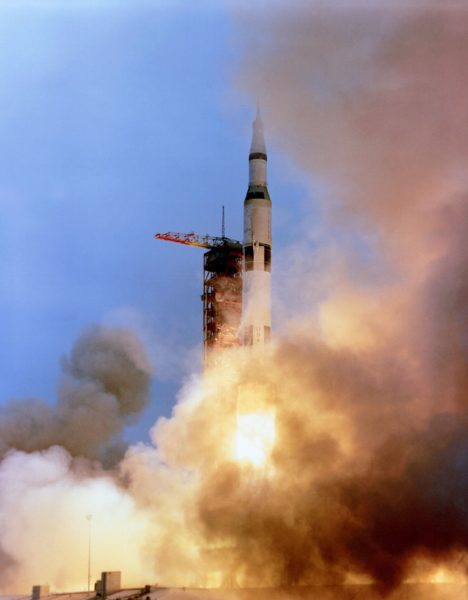
As the rocket blurred into the clouds, I watched the joyful exuberance of the hundreds of kids around me all still spellbound by the launch of Apollo 9. As I kept turning, this view was quickly replaced as the center of my attention by the expressions on the faces of my teachers, the principal and the school nurse. Their expressions took me aback … they were, all of them, crying. Their faces were tear-soaked, their reddened eyes still fixed to the single television set on the school stage.
These were the “other” adults in my life. For three years, they were always prim, always proper and stoic. Now they were crying and laughing at the same time. The scale of this event suddenly became still far larger than I had previously imagined.
The launch of Apollo 9 and what that meant was enough to elicit emotions from adults that until that moment had seemed sort of wooden, educational caricatures, not exactly human. The teachers, the principal, the nurse and I noticed the lunch staff, custodian and librarian were all wiping their faces — the launch of Apollo 9 made all of these adults actually cry.
Somehow this was more than a mere launch of a rocket sending three people into space.
This was an important event, important enough to elicit a transformational reaction that was totally unexpected from a whole community of adults that, until now, seemed to me to have muted emotions. Apollo 9 gave me insight into my teachers and the associated school staff that assisted them in my education. These school adults grew from two-dimensional cartoon characters into multifaceted and highly complex three-dimensional beings that day. I thought, these adults may actually have lives outside of the temporal structure of the structured school day and beyond the spatial boundaries of the grounds of Chamberlayne Elementary School.
I was stunned at the transformative nature of the Apollo 9 launch and decided that I needed to learn more of what just happened and why. I had always been interested in space and space exploration — no doubt this was because I was highly interested in science coupled with personally witnessing the dawning years of human space exploration. Watching the school adults transmute during the Apollo 9 launch offered a glimpse of the human side of space exploration beyond the rockets, an insight into the “why” not just the “how” of human space exploration.
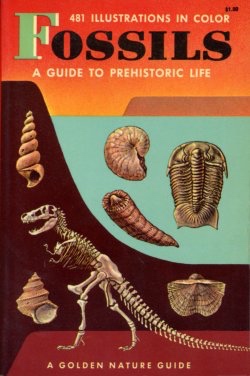
Ten days later, just a few minutes after noon according to the analog clock we all tried not to watch, next to the speaker box, on my front classroom wall, opposite the windows, above the middle of the chalkboard and to the left of the American flag, a very curious thing happened.
It was during silent reading time designed to quiet us while we all anxiously waited. My personal wooden desk was in the far-left row, against the bookshelves, third desk from the back. I was absently reading/scanning a library book, Fossils — A Golden Nature Guide: 481 Illustrations in Color — a Guide to Prehistoric Life.
I had checked out and read this marvelous book dozens of times in the last three years. I was no longer actually reading the book — more like remembering the familiar flow of words amid the cascade of hand-drawn, color illustrations that decorated nearly every page with imagination stimulating sketches of prehistoric life. I was particularly fond of the illustrated dioramas of early life in the shallows of the oceans of the Paleozoic Era. I would travel back and forth in time traveling hundreds of millions of years of evolutionary experimentation from the Cambrian to the Permian Periods with a few turns of a page or two. My mind swam through these ancient shallow seas filled with wondrous and fantastical creatures we only know from their fossil evidence.
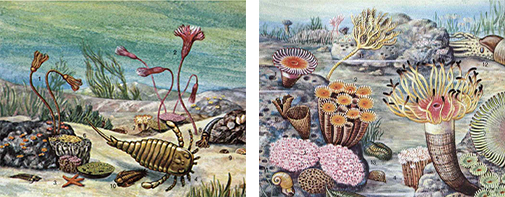
In the center of the deep silence of our waiting there was the faintest murmur, of a sound with a few moments duration. A whispered noise that started, grew, then would go silent. We pretended we did not hear it. There it was again, stepping slowly through the grades and classrooms of our school. A methodical lurching soft sound without any form but that it was, and that it was growing as it rose up through the grade levels.
The sound skipped from building to building and room to room up the staggered walkway leading from the office and the cafeteria to the farthest building that housed the various sixth-grade classrooms. The sound was getting closer. We all tried to ignore it. We tried to read our books, but all we could do was listen and wait, wait our turn for the news. I put my left hand out on the bookshelf attached to the wall that shared another sixth-grade classroom. I could just hear from the other room through the wall a short muffled statement — the students next door erupted in a roar that shook the bookcase. We closed our eyes — we were next in line. The speaker box in our classroom softly buzzed — all eyes were locked on the lacquered wooden box with the fabric circle. This time I was ready — I watched my teacher intently — I wanted to know what was really going on.
From the speaker box came the voice of the principal, bringing each classroom the news “Apollo 9 has landed. They are all back safe.”
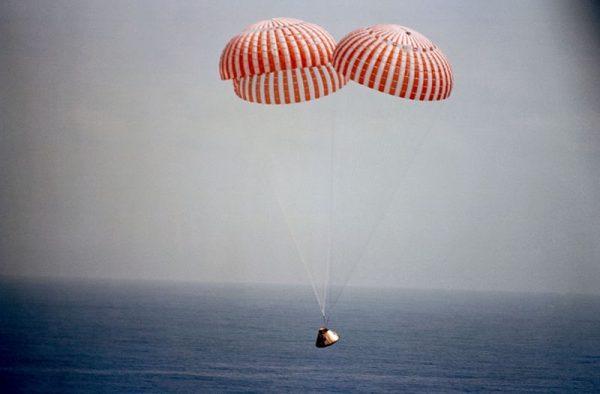
Amid the chaos of cheering around me, I momentarily met my teacher’s watering eyes. After a few seconds my class settled down. My teacher stood and, in a surprisingly clear voice said, “Class — get your coats we are going to have an extra recess.” Either every teacher at Chamberlayne Elementary School had the same idea that afternoon on March 13 in 1969, or it was planned all along — the grass between the buildings and all the playground areas was covered in kids.
I always thought that was a classy thing to do.
I invite you to read an excellent account of the seven alternate mission plans that were being tested on the Apollo 9 mission that would seamlessly kick in if any catastrophic failure occurred in key major hardware component or procedure. Apollo 9 ensured maximum success of the overall mission of getting to the moon and maximizing the likelihood that the astronauts would get back to the Earth safely: NASA’s Bold Apollo 9 Plans Made the Moon Landing Possible by Amy Shira Teitel, published on March 1, 2019.
• Robert E. Strong received a bachelor of arts degree in physics with minors in mathematics and philosophy and has a master’s degree in space studies. Robert taught secondary school math and science in Benin, West Africa, (Peace Corps volunteer) and in American Samoa. He worked as a physicist in a research laboratory. Robert is president of the Near Earth Object Foundation dedicated to educating the general public about Near Earth Objects and providing public StarWatches. Robert and his wife Libby started the SMART-Center in 1994, a hub for science- and math-related activities for area schools, educators and the community. They also operate the SMART Centre Market — an interactive hands-on science store in Wheeling, featuring Orion telescopes, science toys and Kirke’s ice cream.


